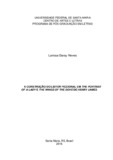| dc.creator | Neves, Larissa Garay | |
| dc.date.accessioned | 2016-07-11 | |
| dc.date.available | 2016-07-11 | |
| dc.date.issued | 2016-02-29 | |
| dc.identifier.citation | NEVES, Larissa Garay. THE CONSTRUCTION OF THE FICTIONAL READER IN THE PORTRAIT OF A LADY AND THE WINGS OF THE DOVE BY HENRY JAMES. 2016. 140 f. Dissertação (Mestrado em Letras) - Universidade Federal de Santa Maria, Santa Maria, 2016. | por |
| dc.identifier.uri | http://repositorio.ufsm.br/handle/1/9953 | |
| dc.description.abstract | Henry James was one of the most renowned writers at the turn of the nineteenth into the twentieth century and is still known for his vast number of literary works and studies about the art of fiction. In his prefaces and critical essays, James discussed his own method of writing fiction, with a special focus on point of view and on issues related to the reception of his fictional work. In this sense, James also considered the importance of the role of the reader to the point of claiming in one of his prefaces: ―attentive reading, I avow, is what, at every point just like here, I completely invoke and hope for‖ (JAMES, 2009, p. 15). This dissertation discusses the construction of the fictional reader in two of James novels: The Portrait of a Lady (1886) and The Wings of the Dove (1902). Written twenty years apart from each other, these novels have meaningful similarities in their themes. The aim is to analyze how differences in the manipulation of point of view have implications to the rhetorical configuration of different readers in the two novels. In The Portrait of a Lady, James basically uses one single center of consciousness to narrate the story and constructs a reader that is gradually more participative and critical. In The Wings of the Dove, on the other hand, James opts for a more impersonal mode of presentation of the story, so the narrative is developed through several centers of consciousness. As a consequence, the configured reader is critical and inferential throughout the whole narrative because the gaps intentionally built by the writer have to be constantly filled. In short, our discussion shows that, along his career, Henry James projected readers that should be more and more critical. | eng |
| dc.description.sponsorship | Coordenação de Aperfeiçoamento de Pessoal de Nível Superior | |
| dc.format | application/pdf | por |
| dc.language | por | por |
| dc.publisher | Universidade Federal de Santa Maria | por |
| dc.rights | Acesso Aberto | por |
| dc.subject | Literatura de língua inglesa | por |
| dc.subject | Romance | por |
| dc.subject | Henry James | por |
| dc.subject | Leitor ficcional | por |
| dc.subject | Literature of the english language | eng |
| dc.subject | Novel | eng |
| dc.subject | Henry James | eng |
| dc.subject | Fictional reader | eng |
| dc.subject | Point of view | eng |
| dc.title | A construção do leitor ficcional em The portrait of a lady e The wings of the dove de Henry James | por |
| dc.title.alternative | The construction of the fictional reader in The portrait of a lady and The wings of the dove by Henry James | eng |
| dc.type | Dissertação | por |
| dc.description.resumo | Henry James é um dos escritores mais renomados da virada do século XIX para o século XX, conhecido por sua vasta produção literária e seus estudos sobre a arte da ficção. Em seus prefácios e ensaios de crítica literária, James discutiu o seu próprio método de escrita de ficção, com especial enfoque no foco narrativo, assim como questões relacionadas à recepção de sua obra ficcional. Assim, James também considerou a importância do papel do leitor: ―leitura atenta, confesso a propósito, é o que eu em cada ponto, como aqui, absolutamente invoco e espero‖ (JAMES, 1998, p. 19), exigia James em um de seus prefácios. Nesse sentido, neste trabalho discutimos a construção do leitor ficcional em dois de seus romances: The Portrait of a Lady (1886) e The Wings of the Dove (1902). Esses romances apresentam semelhanças temáticas significativas, apesar de terem sido escritos em um intervalo de quase vinte anos. Nosso objetivo é analisar como diferenças na elaboração do foco narrativo têm implicações para a configuração retórica de diferentes leitores. Em The Portrait of a Lady, James faz uso de basicamente um único centro de consciência para narrar a história e constrói um leitor gradualmente mais participativo e crítico. Já em The Wings of the Dove, James opta por um modo mais impessoal de apresentação da história, no qual a narrativa é desenvolvida por meio de diversos centros de consciência. Consequentemente, o leitor configurado é crítico e inferencial ao longo de toda a narrativa, pois é necessário que vazios intencionalmente deixados pelo escritor sejam preenchidos constantemente. Assim, nosso trabalho mostra que Henry James projetava leitores cada vez mais críticos na medida em que sua carreira avançava. | por |
| dc.contributor.advisor1 | Ramicelli, Maria Eulália | |
| dc.contributor.advisor1Lattes | http://buscatextual.cnpq.br/buscatextual/visualizacv.do?id=K4791772E4 | por |
| dc.contributor.referee1 | Marques, Mariana Teixeira | |
| dc.contributor.referee1Lattes | http://lattes.cnpq.br/6642210788381723 | por |
| dc.contributor.referee2 | Pereira, Lawrence Flores | |
| dc.contributor.referee2Lattes | http://buscatextual.cnpq.br/buscatextual/index.jsp | por |
| dc.creator.Lattes | http://lattes.cnpq.br/8341885189603743 | por |
| dc.publisher.country | BR | por |
| dc.publisher.department | Letras | por |
| dc.publisher.initials | UFSM | por |
| dc.publisher.program | Programa de Pós-Graduação em Letras | por |
| dc.subject.cnpq | CNPQ::LINGUISTICA, LETRAS E ARTES::LETRAS | por |


